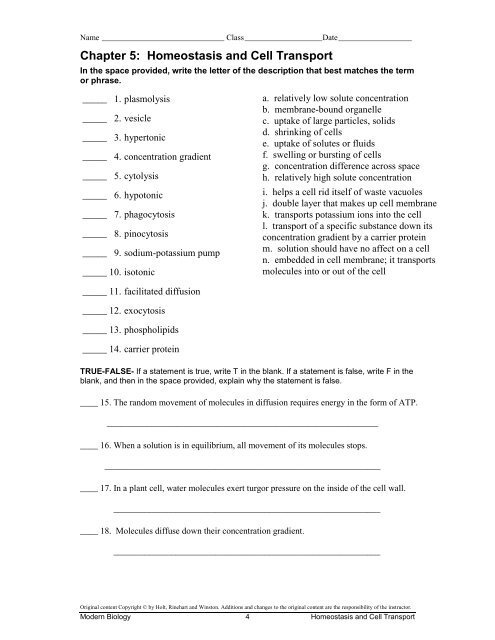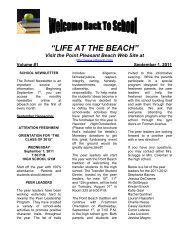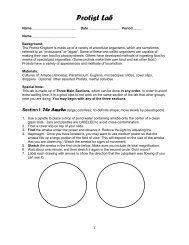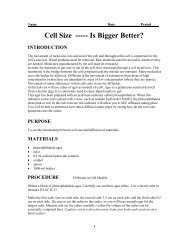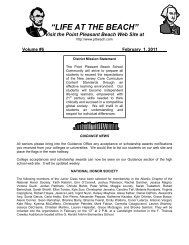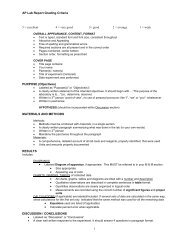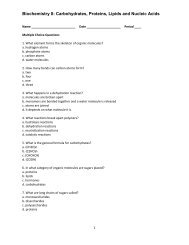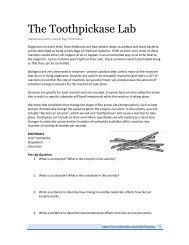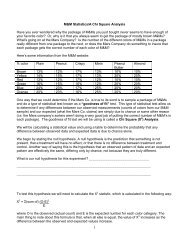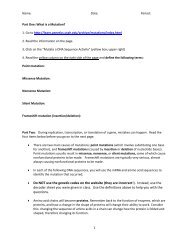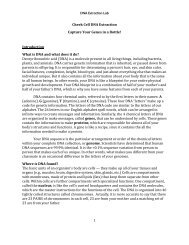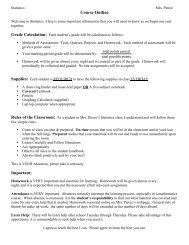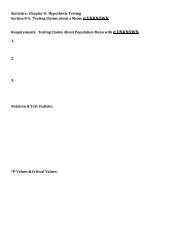Chapter 5: Homeostasis and Cell Transport
Chapter 5: Homeostasis and Cell Transport
Chapter 5: Homeostasis and Cell Transport
You also want an ePaper? Increase the reach of your titles
YUMPU automatically turns print PDFs into web optimized ePapers that Google loves.
Name ______________________________ Class ___________________ Date __________________<br />
<strong>Chapter</strong> 5: <strong>Homeostasis</strong> <strong>and</strong> <strong>Cell</strong> <strong>Transport</strong><br />
In the space provided, write the letter of the description that best matches the term<br />
or phrase.<br />
_____ 1. plasmolysis<br />
_____ 2. vesicle<br />
_____ 3. hypertonic<br />
_____ 4. concentration gradient<br />
_____ 5. cytolysis<br />
_____ 6. hypotonic<br />
_____ 7. phagocytosis<br />
_____ 8. pinocytosis<br />
_____ 9. sodium-potassium pump<br />
_____ 10. isotonic<br />
a. relatively low solute concentration<br />
b. membrane-bound organelle<br />
c. uptake of large particles, solids<br />
d. shrinking of cells<br />
e. uptake of solutes or fluids<br />
f. swelling or bursting of cells<br />
g. concentration difference across space<br />
h. relatively high solute concentration<br />
i. helps a cell rid itself of waste vacuoles<br />
j. double layer that makes up cell membrane<br />
k. transports potassium ions into the cell<br />
l. transport of a specific substance down its<br />
concentration gradient by a carrier protein<br />
m. solution should have no affect on a cell<br />
n. embedded in cell membrane; it transports<br />
molecules into or out of the cell<br />
_____ 11. facilitated diffusion<br />
_____ 12. exocytosis<br />
_____ 13. phospholipids<br />
_____ 14. carrier protein<br />
TRUE-FALSE- If a statement is true, write T in the blank. If a statement is false, write F in the<br />
blank, <strong>and</strong> then in the space provided, explain why the statement is false.<br />
____ 15. The r<strong>and</strong>om movement of molecules in diffusion requires energy in the form of ATP.<br />
_____________________________________________________________<br />
____ 16. When a solution is in equilibrium, all movement of its molecules stops.<br />
______________________________________________________________<br />
____ 17. In a plant cell, water molecules exert turgor pressure on the inside of the cell wall.<br />
____________________________________________________________<br />
____ 18. Molecules diffuse down their concentration gradient.<br />
____________________________________________________________<br />
Original content Copyright © by Holt, Rinehart <strong>and</strong> Winston. Additions <strong>and</strong> changes to the original content are the responsibility of the instructor.<br />
Modern Biology 4 <strong>Homeostasis</strong> <strong>and</strong> <strong>Cell</strong> <strong>Transport</strong>
Name ______________________________ Class ___________________ Date __________________<br />
In the space provided, write the letter of the term or phrase that best completes<br />
each statement or best answers each question.<br />
______ 19. The process of diffusion requires<br />
a. a cell membrane.<br />
b. an aqueous solution.<br />
c. a difference in the concentration of molecules throughout a space.<br />
d. All of the above<br />
______ 20. If the molecular concentration of a substance is the same throughout a space, the<br />
substance<br />
a. has a large concentration gradient.<br />
b. is in equilibrium.<br />
c. will undergo diffusion.<br />
d. will undergo osmosis.<br />
______ 21. If the concentration of a sugar solution is lower outside the cell than inside the<br />
cell, which of the following will happen by osmosis?<br />
a. Sugar will move into the cell.<br />
b. Water will move into the cell.<br />
c. Sugar will move out of the cell.<br />
d. Water will move out of the cell.<br />
______ 22. A type of transport in which water moves across a membrane <strong>and</strong> down its<br />
concentration gradient is<br />
a. simple diffusion. c. diffusion through ion channels.<br />
b. facilitated diffusion. d. osmosis.<br />
______ 23. Net movement of water across a cell membrane occurs<br />
a. from a hypotonic solution to a hypertonic solution.<br />
b. from a hypertonic solution to a hypotonic solution.<br />
c. from an isotonic solution to another isotonic solution.<br />
d. through gated water channels.<br />
_____ 24. All forms of passive transport depend on<br />
a. energy from the cell in the form of ATP.<br />
b. the kinetic energy of molecules.<br />
c. ion channels.<br />
d. carrier proteins.<br />
______ 25. Plasmolysis of a human red blood cell would occur if the cell were<br />
a. in an isotonic solution. c. in a hypotonic solution.<br />
b. in a hypertonic solution. d. None of the above<br />
______ 26. A structure that can move excess water out of unicellular organisms is a<br />
a. carrier protein.<br />
b. contractile vacuole.<br />
c. ion channel.<br />
d. cell membrane pump.<br />
Original content Copyright © by Holt, Rinehart <strong>and</strong> Winston. Additions <strong>and</strong> changes to the original content are the responsibility of the instructor.<br />
Modern Biology 4 <strong>Homeostasis</strong> <strong>and</strong> <strong>Cell</strong> <strong>Transport</strong>
Name ______________________________ Class ___________________ Date __________________<br />
______ 27. The diffusion of ions across the membrane is influenced by which of the<br />
following?<br />
a. the electrical charge of the ion<br />
b. only the concentration gradient of the ion<br />
c. the number of enzymes in the cell membrane<br />
d. Both (a) <strong>and</strong> (c)<br />
______ 28. Which of the following is NOT a characteristic of active transport?<br />
a. It moves substances against a concentration gradient.<br />
b. It requires energy from the cell.<br />
c. It involves facilitated diffusion.<br />
d. It relies on carrier proteins that often function as pumps.<br />
______ 29. Diffusion is the movement of a substance<br />
a. through only a lipid bilayer.<br />
b. from an area of low concentration to an area of higher concentration.<br />
c. only in liquids.<br />
d. from an area of high concentration to an area of lower concentration.<br />
______ 30. Molecules that are too large to be moved through the cell membrane can be<br />
transported into the cell by<br />
a. osmosis. c. exocytosis.<br />
b. endocytosis. d. diffusion.<br />
______ 31. Sodium-potassium pumps<br />
a. move Na + ions <strong>and</strong> K + ions into cells.<br />
b. move Na + ions <strong>and</strong> K + ions out of cells.<br />
c. move Na + ions out of cells <strong>and</strong> K + ions into cells.<br />
d. move Na + ions into cells <strong>and</strong> K + ions out of cells.<br />
Read each question, <strong>and</strong> write your answer in the space provided.<br />
32. Name three types of passive transport <strong>and</strong> three types of active transport.<br />
______________________________________________________________________<br />
______________________________________________________________________<br />
______________________________________________________________________<br />
33. Describe what would happen to the molecules in a drop of ink dropped into a beaker of<br />
water. What is this process called?<br />
______________________________________________________________________<br />
______________________________________________________________________<br />
34. What is the fundamental difference between carrier proteins that participate in facilitated<br />
diffusion <strong>and</strong> carrier proteins that function in active transport?<br />
______________________________________________________________________<br />
______________________________________________________________________<br />
______________________________________________________________________<br />
Original content Copyright © by Holt, Rinehart <strong>and</strong> Winston. Additions <strong>and</strong> changes to the original content are the responsibility of the instructor.<br />
Modern Biology 4 <strong>Homeostasis</strong> <strong>and</strong> <strong>Cell</strong> <strong>Transport</strong>
Name ______________________________ Class ___________________ Date __________________<br />
35. Contrast endocytosis with exocytosis.<br />
______________________________________________________________________<br />
______________________________________________________________________<br />
______________________________________________________________________<br />
______________________________________________________________________<br />
Extra Credit, Critical Thinking.<br />
36. The diagrams below illustrate cells carrying out different types of transport across their<br />
cell membranes. Identify each process by writing the correct term in the blank below<br />
each diagram. Then answer the question.<br />
g. Which of the above processes are active-transport processes?<br />
______________________________________________________________________<br />
Original content Copyright © by Holt, Rinehart <strong>and</strong> Winston. Additions <strong>and</strong> changes to the original content are the responsibility of the instructor.<br />
Modern Biology 4 <strong>Homeostasis</strong> <strong>and</strong> <strong>Cell</strong> <strong>Transport</strong>


